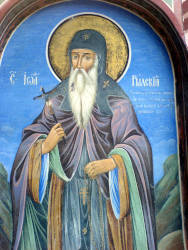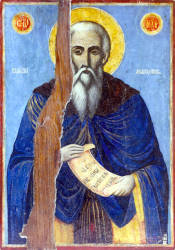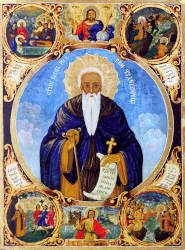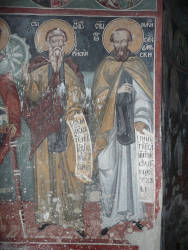Пещера на Иван Рилски
Cave of St. Ivan Rilski - Sacred Hole of the Righteous
Useful Information



| Location: |
Near the Рилски манастир (Monastery of Saint Ivan of Rila).
From the monastery follow road 107 up valley for 3.6 km, there is a hairpin left, then a hairpin right, in the latter is the small parking lot along the road. On opposite side of road follow trail uphill, 500 m/10 min walk. (42.1501008, 23.3699140) |
| Open: |
no restrictions. [2021] |
| Fee: |
free. [2021] |
| Classification: |
 Cave Church Cave Church
|
| Light: | bring torch |
| Dimension: | |
| Guided tours: |
self guided
Monastery: V=900,000/a [2008] |
| Photography: | allowed |
| Accessibility: | no |
| Bibliography: | |
| Address: |
Рилски манастир, обл. Кюстендил, П.К. 2643, Tel: +359-7054-3383.
E-mail: |
| As far as we know this information was accurate when it was published (see years in brackets), but may have changed since then. Please check rates and details directly with the companies in question if you need more recent info. |
|
History
| 876 | St. Ivan Rilski born at Skrino. |
| 927 | Rila Monastery founded. |
| 946 | St. Ivan Rilski died at nis cave. |
| 1334–1335 | the Tower of Hrelja built. |
| 1343 | church erected. |
| 1385 | first written mention of the church at the cave. |
| mid 15th century | after the arrival of the Ottomans numerous raids and destruction of the monastery. |
| late 15th century | rebuilt by three brothers from the region of Dupnica. |
| 1833 | destroyed by fire. |
| 1834-1862 | monastery rebuilt. |
| 1976 | monastery declared a national historical monument. |
| 1983 | inscribed on the UNESCO World Heritage List. |
| 1999 | depicted on the back of the 1 lev banknote. |
Description






The Рилски манастир (Rilski Manastir, Rilski Monastery) is probably the most famous monastery in Bulgaria. The characteristic buildings made of white and dark brown stones, forming striped patterns on the walls and arches, arcades painted with frescoes, and lots of cupolas, are quite impressive. Today it houses around 60 monks, and offers daily services and baptisms. It’s also a popular tourist site with crowds during holiday season. Пещера на Иван Рилски (Cave of St. Ivan Rilski) is not far, and named after the same saint, but almost unknown and rarely visited. That’s actually the way St. Ivan Rilski would have liked it, it was his retreat for praying in solitude, inside a small natural cave. It was his hermitage for seven years and according to legend it is his burial place. Later a church was built at the entrance, supposedly by the first monks of the Rila Monastery, but the cave is almost in the same state it was when the saint lived here. It is called Church of the Dormition of St. John of Rila and contains frescoes similar in style to those of the St. John the Theologian Chapel in the eastern wing of the monastery. At the western side of the narthex is the grave of St. John of Rila. It is actually not the grave of the saint, he was buried here at first, but soon after his remains were relocated to Sofia, where he is actually buried now. Nevertheless, believers come to this place and worship the empty grave, which is even weirder than the rest of the pilgrim stuff. The cave is freely accessible, but the church is open only during festivities.
Св. Иван Рилски (St. Ivan Rilski) was born in the village of Skrino in 876. Until the age of 25 he was a shepherd, but then his parents died. He gave up everything and donated his inheritance to poor and sick people. Then he became a novice in the monastery St. Dimitar (St. Dimitrii monastery) at the foot of mount Ruen. He received a clerical rank and accepted monasticism. He devoted himself to fasting and prayer, and first served in Vitosha Mountain, then in Rila, before the famous monastery was built. He spent 20 years in solitude, praying to God amd eating only herbs and fruits. His reputation as a healer spread and many sick people came to him to be healed from diseases and mental anguish. And he performed many miracles. Spiritual young people began to come to him, who wanted to become his disciples. He lived seven years in the cave, which is also called the Свещената дупка на праведника (Sacred Hole of the Righteous). The ascetic made his disciples to vow not to kill animals and not to eat meat. This rule has been valid for all monks since the construction of the Rila Monastery. St. Ivan Rilski died at the age of 70 in 946.
Свети преподобни Йоан Рилски Чудотворец (Svеti prеpodobni Yoan Rilski Chudotvorеts, Saint (monk) John of Rila the Wondermaker) was the first Bulgarian hermit. He was revered as a saint while he was still alive, his followers founded many churches and monasteries. He is the patron saint of the Bulgarians and one of the most important saints in the Bulgarian Orthodox Church. His dormition is commemorated each year on August 18 and October 19.
The fame of St. Ivan Rilski spread and finally reached Tsar Peter I of Bulgaria in Veliki Preslav. Tsar Peter I travelled 450 km to the Rila Mountains in order to meet St. Ivan and seek spiritual advice. St. Ivan refused to meet the tsar in person to avoid the temptation of vanity and pride due to the extraordinary visit. The two men only bowed to each other from a distance. The tsar sent a soldier to deliver the gifts, fruits and gold, the saint accepted the fruits, but not the gold. He advised the tsar, that monarchs need gold in order to protect the country and help the poor.
When you come to the chapel, follow the wooden sign along the right wall of the chapel. Finally, you reach a stone staircase which leads up to the cave entrance. Then the stairs lead up inside the cave, until you finally reach a narrow passage which opens on the plateau above the cave. This passage is the so-called Свещената дупка на праведника (Sacred Hole of the Righteous) and according to tradition people come to the cave to cross this passage. Many say that every Bulgarian should go through the Sacred Hole in the cave of St. Ivan Rilski to purify himself spiritually. But despite this is considered a christian tradition, it is actually a prehistoric "rebirthing" ceremony. Rocks with holes, which were used for such transition rituals, were found in megalithic dolmens. However, as this are prehistoric traditions, there are no written documents, which would give us an idea how this worked. We only have this much younger Christian variety.
St. Ivan Rilski made his disciples vow, not to kill animals and not to eat meat. This rule was once broken, and then the healing spring above the cave dried up for a week. It never dried up, not even in the coldest winter, except for this one time.
Rila is the highest mountain range of Bulgaria, the Balkan Peninsula and Southeast Europe. The highest summit is Musala (2,925 m asl). The mountains are composed mostly of crystalline rocs like granite, ambhibolithes, gneis and mica shists. There are also small areas of marble, but no caves of importance.
- See also
 Subterranean World Heritage List
Subterranean World Heritage List Search DuckDuckGo for "Cave of St. Ivan Rilski"
Search DuckDuckGo for "Cave of St. Ivan Rilski" Google Earth Placemark
Google Earth Placemark John of Rila - Wikipedia (visited: 20-AUG-2021)
John of Rila - Wikipedia (visited: 20-AUG-2021) Rila Monastery - Wikipedia (visited: 20-AUG-2021)
Rila Monastery - Wikipedia (visited: 20-AUG-2021) Rila Monastery - UNESCO World Heritage List
Rila Monastery - UNESCO World Heritage List The Old Hermitage, official website (visited: 20-AUG-2021)
The Old Hermitage, official website (visited: 20-AUG-2021) Пречистване на душите през Свещената дупка на Св. Иван Рилски
Пречистване на душите през Свещената дупка на Св. Иван Рилски  (visited: 20-AUG-2021)
(visited: 20-AUG-2021) Пещерата на Св. Иван Рилски - с. Скрино
Пещерата на Св. Иван Рилски - с. Скрино  (visited: 20-AUG-2021)
(visited: 20-AUG-2021) Holed Stones and Crawling Through Rituals (visited: 20-AUG-2021)
Holed Stones and Crawling Through Rituals (visited: 20-AUG-2021)
 Index
Index Topics
Topics Hierarchical
Hierarchical Countries
Countries Maps
Maps